Welcome to a new issue of the Journal of Runic Studies, the premier Malkioni publication for studies into the nature of Glorantha. If you haven’t subscribed yet, please consult with the spirit bound to the appropriate electronic page.
You get a lot more guest entries by Jörg this week since I was away on a ski trip in a little lodge in northern Fronela. Family time is important even with the Malkioni, you know! Although I have to say, it seem that kids learn to Tap magic points from an early age, judging by how much I’m tired these days. Oh well. On to Gloranthan news! I may have missed a few things this week, and as someone famous once said, I didn’t have time to make it shorter.
Don’t forget, you can contact us if you want to submit guest entries or otherwise help with the newsletter.
God Learner Sorcery
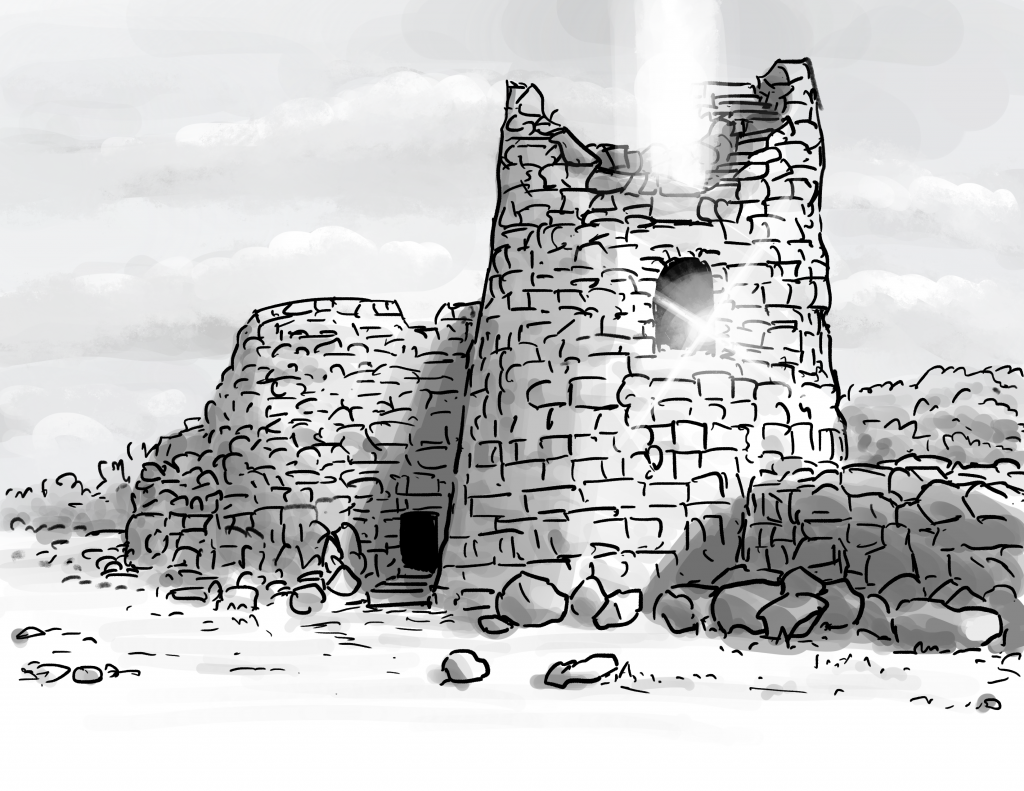
We are now occupying a nice little tower with a long history of previous occupants who have left behind documents, tablets, artifacts, and other kinds of junk. As we clean up and archive these things, we share the most interesting ones with you.
Episode 7: Adventures in Jonstown
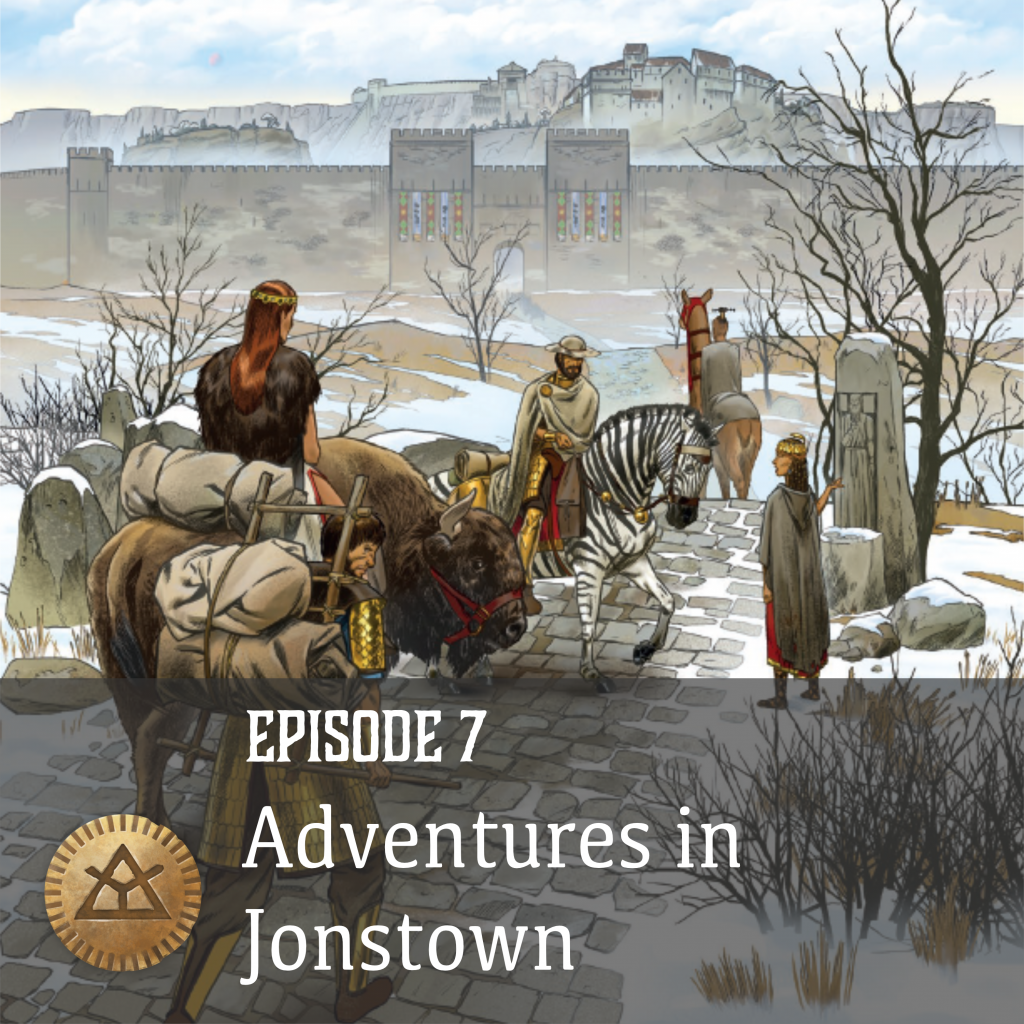
Episode 7 of our podcast is finally out! We’re looking after the people who got the RuneQuest Starter Set during the holidays! With guest Diana Probst of Beer With Teeth, we discuss ideas for more adventures in Jonstown after the 3 scenarios found in the box. Plus: some exclusive news about what Beer With Teeth and Chaosium are up to together!
Chaosium News

Here are this week’s Chaosium news!
Cults of Glorantha Interview
Jeff talks about his big RuneQuest project for 2022, the much awaited Cults of Glorantha slipcase set, which should include two big cults books, and one smaller (although still about 128 pages long) Prosopaedia.
- The Prosopaedia is a reference list of all gods, goddesses, notable spirits, and heroes of the setting. It’s illustrated entirely by the unfatiguable Katrim Dirim.
- The Cults books seem to be organized by pantheons: Darkness, Water, Earth, Fire/Sky, Lightbringers, Lunar, Horned God and animist religions, and Chaos. Note that “regional gods” like Pavis won’t be present: they will be in their relevant regional sourcebooks (such as the Pavis book, duh). Then there’s some mythology overview, monomyth, RuneQuest rules, essays, cult distribution and compatibility charts. It’s “lavishly” illustrated by Loic Muzy and Agathe Pithie (you should have seen sneak peeks of some of these art pieces by now), plus a few others, including some new maps, which I assume includes new mythic/God Learner maps.
The books are currently in layout and graphic design. Jeff hopes to have the PDFs out “by the end of the first quarter”.
Jeff is visibly excited about many aspects of this project, so watch to video to hear what he’s most excited about!
New Gamemaster Month Is Starting
Guest entry by Jörg.

Chaosium is one of six publishers participating in the New Gamemaster Month initiative by Monte Cook Games, this year featuring RuneQuest (among others) with the material from the Starter Set.
New content is published on the website twice a week, with an introductory post and two “lessons” already available. There is also a Discord server and a Facebook Group for the course, and an introduction to using Roll20 parallel to the game-specific courses, although unfortunately not (yet) for the RQG rules.
Welcome And Let’s Get Started covers the practical aspects of getting players, getting the game material, and familiarizing yourself with the rules. For RuneQuest, that means the Starter Set, which you can order from Chaosium’s website with a 10% rebate all of January. The tutorial assumes that you have the physical set in your hands already, but you can use the PDF version as soon as your order gets processed. If you got your set from your friendly local game store, good for you because you don’t have to wait for your copy and can start right away. In that case, you might try and use that code for the core rules book.
The course material doesn’t say so, but you can also familiarize yourself with the the most relevant rules on the RuneQuest-Wiki.
Initial Planning For Your Game Session talks about prep-work for your game, and gives an estimate of the amount of time a gamemaster may have to put in beyond actually running the game. The RuneQuest section offers advice for player recruitment, asks you once more to skim a look at the rules, and then already points you to have some fun – you are supposedly ready to try the solo adventure now.
If you are still undecided whether to invest in the RuneQuest Starter Set, take a look at the Wiki, then the online SoloQuest, or even our own thorough review of the product. If you have experience with D100 games of the Basic Roleplaying family, you should be able to get by with that information.
Sneak Peek at the Non-Human Pre-gen Adventurers
Entry co-written with Jörg.
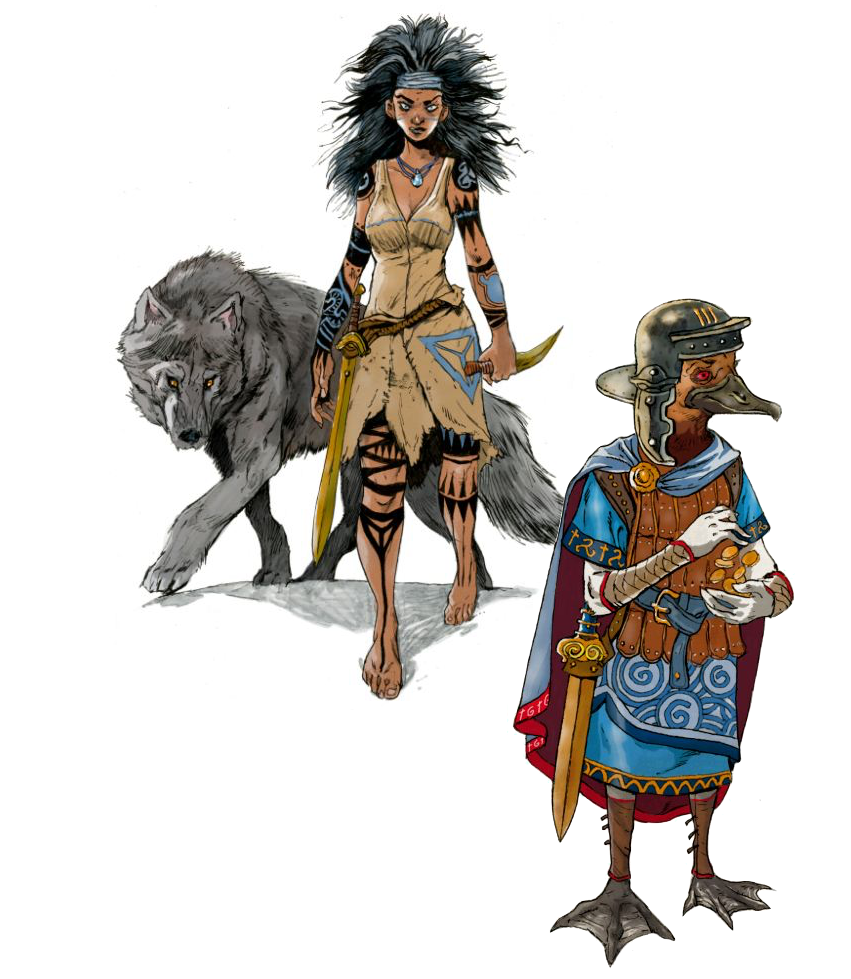
Chaosium has posted a sneak peek at two upcoming pre-generated adventurers for RuneQuest’s Starter Set: a Telmori Wolfsister and an Issaries Duck.
Showing a Telmori girl as an example of a non-human strikes me as a little odd, but she is looking gorgeous and pretty untamable. And the duck looks mean, too. Release date is “later this year”.
Jason Durall started a thread of comments with extra information:
Pretty much every nonhuman race has a sample pregen. I drew the line at Windchildren and Dragonewts, because the first were just too weirdly unbalanced, and the second were too complex to get across in a pregen folio description.
The [Windchildren’s] flying is great – maybe even scenario-breaking – but they’re so restricted in what they can carry, what armor they can wear, and their intense claustrophobia limits them considerably for adventuring.
Grab Your Updated PDFs
Guest entry by Jörg.
In related news, the known errors in the RuneQuest Starter Set, like the alynx with bison stats, are supposed to be eliminated when corrected PDFs get uploaded soon, and there already are updated PDFs of the Weapons and Equipment Guide available on the Chaosium or Drivethrurpg shop/order pages if you bought them there.
Jonstown Compendium

The Jonstown Compendium is Chaosium’s community content program for all Gloranthan games, hosted on DriveThruRPG. Disclaimer: all the relevant links are affiliate links that hopefully will let us cover some of the hosting and maintenance costs for the website and podcast! Thanks for using them!
More Glorantha Maps
Mikael Mansen is churning out more maps, with three more “generic settlement” maps (a port town, a scattered shoreline village, an island settlement, and a river town), and a map of the region around the Hellcrack, a magical chasm up in the steppes of Pent where you can fall down to the Underworld.
Jeff’s Notes

Jeff Richard, the current mastermind on everything Gloranthan at Chaosium, is often posting notes and thoughts on the RuneQuest Facebook group. Here’s our curated list from the past week. A partial archive of these sources is compiled on the Well of Daliath.
What is Magic
Sometimes fairly foundational bits of lore can be overlooked, which is why Jeff points us to the RuneQuest rulebook’s Magic chapter introduction (on p243). I agree that this is the kind of rulebook material I tend to skim, or read but not commit to memory. Which is why whenever I re-read the rulebook or the bestiary I often pick up little gems I missed or forgot.
I’m not going to quote the whole thing (you have the rulebook after all, don’t you?), but it boils down to this:
The dualistic worlds of eternal God Time and mortal Time are the basic polarities of Glorantha. From these opposing poles comes all known reality. Magic is the result of the interaction of these two worlds; drawing upon the timeless and eternal God Time to affect the mortal world of Time.
I figure that this mostly applies to Rune Magic, where indeed a mortal uses their connection to a deity that “resides” in the God Time, and channels something they “did” to make it happen again right now. This is how an Orlanth worshipper can, say, summon a thunderbolt, which is effectively “magic”.
Compare that to spirit magic which calls upon the denizens of the Spirit World who exist in a sort of parallel universe to the world of mortals and Time. These entities have various abilities that can have an effect in the mortal world, such as closing wounds or sharpening a blade. Or consider sorcery, which is about using and affecting the Runes that are the underlying building blocks of the Gloranthan universe.
In fact, I’ve seen references to the “Three Worlds” or “Four Worlds” of Glorantha in past material, and where interaction with each of these worlds provides a different type of magic. In this model, you can generalize the quote above, with the God Time specifically providing only divine magic (also known as Rune Magic in the latest RuneQuest game). I’m not sure whether this “multiple worlds” model is still valid as far the game desigers are concerned, but you can bet that there are NPCs in-game who have that world view.
Arguably, both the Spirit World and the Runes are related to the God Time anyway: in another model of Glorantha, the Spirit World was separated from the mortal world at the Dawn, and the abstract world of Runes is sort of the precursor to the God Time, before entities awakened and became the Celestial Court that embodied these Runes.
Cryptic One-Liners in Gloranthan Canon
Some things are intentionally left unexplained, as was mentioned on BRP Central, and later reposted on Facebook:
Rick Meints: I had the pleasure of occasionally cornering Greg and getting the chance to ask him about these sorts of things. In general, Glorantha is full of a lot of “one-liner” references that never really got fleshed out. By “one-liners” I mean that they are mentioned only once or twice and often with just a single sentence. Another such example of a one-liner would be Falangian Wine in King of Sartar. When I asked about that Greg just said, “That’s up to the reader to decide what it is”.
Jeff: Yep. And a lot of these one-liners should not and will not get defined outside of the individual reader.
The effort to answer all questions, to resolve all mysteries – well, that is what destroyed the Second Age. Ponder that carefully and get a bonus to your Illumination role next Sacred Time!
Zzabur
Jeff posts about Zzabur, our good ol’ buddy here at the God Learners:
[Zzabur is] the son of Malkion in most stories, and the First Wizard. Supposedly he’s been around for more than five thousand years and is the master of the Brithini sorcerer caste, and his sorcery is said to have destroyed entire nations, closed off the seas, and twice nearly changed the very nature of the world.
Wonderful dude, isn’t he? The Brithini caste are a bunch of amoral sorcerers who maintain immortality by adhering to strict life rules, which aren’t necessarily great for those around them. Wonderful bunch too.
A word of caution: this whole section of Gloranthan lore seems to be a giant minefield. It’s complicated, been revised multiple times, and is composed of lots of moving parts found in unofficial or unfinished works… plus, I’m still a big newbie. So as usual I’m just trying to figure this out, same as you, but I figured I would add a more explicit disclaimer this time.
Malkion was the child of some minor Air deity (Aerlit, a follower of Vadrus) and of a Triolini (Warera, the shoreline mother, which probably looked like some kind of siren, but who knows, it’s the God Time, things were weird back then). Looking this up I only now realize why the Malkioni are so tied to “water themes”: not only is Malkioni half-Triolini (merfolk), he’s also the father of Waertag and, therefore, the Waertagi, a race of sea-faring humanoids with webbed hands and feet and blue or green skin. This special relationship explains how the Malkioni’s Middle Sea Empire got so much help and achieved their naval supremacy.
An interesting aside on Malkion as Zzabur’s father is this:
Good old Zzabur is usually claimed as Malkion’s first or second son with the goddess Britha. Zzabur was given the Great Gift of sorcery from his father, who was a mortal beings, not a god.
It’s hard to figure out who is a mortal and who isn’t when things happen in the God Time, but my guess is that you’re a mortal if (1) you refuse to be part of the Compromise and enter the world of Time at the Dawn or (2) you got killed in the Gods War. Malkion belongs to that second category.
Anyway, back to Zzabur:
He’s kind of a Pandelume figure from Vance’s Dying Earth. Like Pandelume, Zzabur possesses knowledge of many things which are otherwise lost or unknown to mortals, “including the method of creating artificial life, of all the spells which have ever been invented, and of mundane sciences such as mathematics.” But like Pandelume, Zzabur is a mortal (if ageless). He is not perfect nor infallible, although he never admits an error. And like Pandelume, Zzabur no longer exists in this world, as he and his island of Brithos have vanished from the mundane world, to no one’s regret.
The island of Brithos disappeared around the time of the Closing of the Seas, which is why some people think that the Closing was a side-effect of Zzabur’s spell to move the island out of the Mortal World. It’s not clear where the island went, but note that you can have your adventurers visit the place: there’s a port city in western Genertela where sailors from Brithos sometimes show up and lead you there! How intriguing…
Zzabur is interesting because of his contradictions, and the fine line he’s walking. As far as I can tell, being a big intellectual wizard, he rejects the Gods of Glorantha as nothing more than a bunch of selfish bullies and narcissistic divas, imperfect emanation of the “pure” Runic concepts that make up reality. At best they’re peers, who achieved as much as him. But on the other hand Zzabur can’t really become an immortal in the sense of “existing in the God Time” because that would make him a deity himself. So my guess is that he found an alternative, and that’s where him and his little island currently are.
I imagine Zzabur is incredibly alone, removed from even his fellow Brithini. He remembers interacting with the gods, views them as beings like himself – but he is not a god. He was a first hand witness to many of his father’s pronouncements, at least to begin with. But Zzaburi rejected his father’s second revelation – that of Solace and he did not accompany his father when he departed Brithos. Some claim Zzabur was a parricide and was even responsible for Malkion’s death, but most say he turned his back on his father and made his own arrangements to survive the end of the world.
“Solace” in Malkioni philosophy seems to be the somewhat intellectually abstract state of bliss that awaits you after death if you live your life correctly — for a certain definition of “correctly”. I haven’t found a good explanation of this falling out between Zzabur and Malkion (feel free to contact us and point me to it!), but from what I can see, Zzabur might not have really appreciated Malkion coming out of the Tower of Reason. Malkion might have done that to go educate the masses, so to speak, and indeed bring them the revelation of Solace. Maybe that’s what Jeff is referring to here?
Of course Zzabur is pure ego – he is the great objectifier. He is the intellect that stands between Us and Things. He seeks to survive at whatever cost, knowing that as a mortal his ego is all there is to him – the soul is sentimental drivel and spirit is merely an animating energy. Egoism is his drive – a very personal egoism. “I AM that I AM.”
He is also a very very very old mortal who lives alone in a tower and knows lots of things.
If Brithos is now in some kind of “Ego Plane”, I wonder what that looks like… my first thought is: Zzabur zzabur? Zzabur zzabur zzabur. Zzabur!
Jeff adds one last comment:
Greg never liked Zzabur and what he stood for (and thus in all of Greg’s stories, Zzabur comes over as an unmitigated arrogant prick), but he was an important part of Glorantha and one of its earliest characters.
The Way of Hrestol
Let’s continue with the Malkioni theme, here:
The Way of Hrestol began in the land of Seshnela in the year 2 ST, but its importance stems from the culture from which it separated, the Brithini. This prehistoric culture began long before the Darkness and it’s the root of the Western culture of Glorantha.
The ancient race of Brithos was called the Malkioni after its father and founder, or sometimes Brithini after the island goddess who was the mother of that people.
Talar was eldest, and he received the Crown of Malkion as his share of his father’s realm; Zzabur the Sorcerer Supreme was second, and was master of the spiritual world; Horal Swordson was third, and was a soldier who carried a sword from Humakt the war god; and Dronar Plow was last, who had so many children who worked merrily for the support of the older brothers.
Here we can see how the basic separation of roles in Malkioni society is based on Malkion’s own family. In Western culture, Talars (after Talar) are the nobles and political leaders, Zzaburi (after Zzabur) are the wizards and philosophers and intellectuals, Horali (after Horal) are the soldiers, and Dronars (after Dronar) are the farmers.
Jörg says: The simplistic version has all Brithini and all Malkioni descend from this union. There are other genealogies and stories about the Six Tribes of the Logicians, of which we still know the Waertagi. The God Learner Maps in the Guide name the tribes and their suffering and terminal fates in the Gods War.
The Malkioni fared well during the War of the Gods, especially with the skills of Zzabur, who was as powerful as many of the gods of the time. Once, they even forestalled a dire internal dispute which could have torn them apart and made them easy pretty for Chaos, as happened to so many others.
This event led to the departure of Talar’s eldest son, Froalar, Prince and heir to the throne, from Brithos to avoid a civil war with his brothers. Many others went with him, and they started the first Malkioni colony called Froalarwal (later shortened to Frowal) in Seshnela.
Seshnela was destroyed at the end of the Second Age when the God Learners ran out of excuses with the cosmos, and it snapped back at them… so now Frowal is just a bunch of ruins.
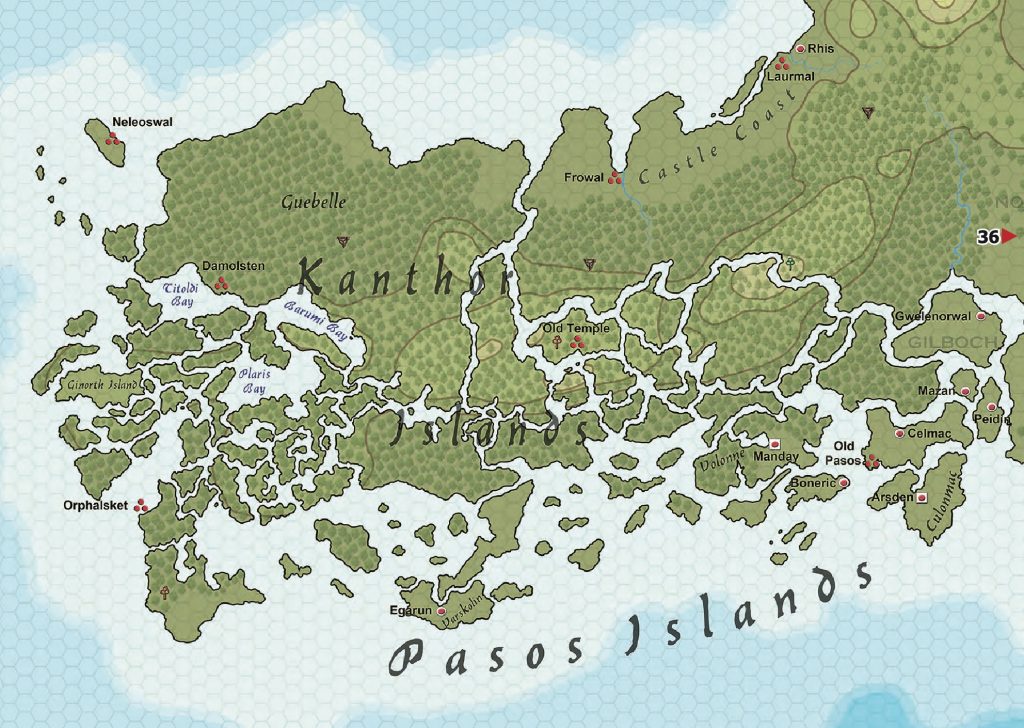
Froalar led his people, called the Seshnegi, through the Great Darkness, and even aided the hostile beast worshipers of the wild who were his enemies.
His wife, Xemela, performed a heroic self-sacrifice and saved her people from darkness demons and Chaos. When the Dawn came, the peoples of Frowal found themselves well off in comparison to the rest of the world.
From what I can tell, these “hostile beast worshipers” might have been the Pendali lion people, who were created by Seshna Likita, the local earth goddess (more on her shortly). The Pendali tribe belongs to the broader Hsunchen Basmoli lion people, who all are some kind of were-lion shapeshifters.
The story of Froalar’s settlements is pretty vague in the Guide or the Sourcebook, which is part of the fun of Glorantha for me: you get a few evocative statements, and you get to make up everything in between!
However, the wild hill barbarians showed no gratitude or friendship, and quickly returned to harassment and war. Froalar and his court zzaburi were distressed as to the proper course of action. The goddess Ifttala, a daughter of Seshna Likita the Earth Goddess, was the mother of the hill barbarians and as long as she aided them, the Dawn Age would be ruled by war and conflict.
And so, in the spring of the second year of Time, Prince Hrestol, the son of King Froalar, swore to slay Ifttala and bring peace to the land. When Hrestol asked his father’s zzaburi how this could be done, they said: “You must be as a god and know what they know. You must be a leader, as you are now. But it is not enough. You must be a warrior, and know how to wield a sword as well as any man bred to it. You must know prayers, like your cousins who study under me. And you must know the secrets of the earth, like the plowmen who feed us. Only thusly by combining the four tasks which Malkion gave to his sons will you be as a god to perform a god’s task.”
The court feared this was blasphemy, and Hrestol purified himself and went to the temple of Malkion the Founder to ask the ancestor. Malkion revealed himself to Hrestol and presented the hero with a helm and shield, armor and a sword, and a book. And as he did so he spoke saying, “Let the old ways be changed in Seshneg, for you are set upon by a mighty foe. Let those who would lead do so. Let those who would fight do so. Let those who would reap and sow do so. Let those who would study and learn sorcery do so. Go forth, and do as you wish, for my blessings go with you. And may all the gods look upon you with favor.”
So there you have Hrestol basically saying that he will forego the ancestral “caste” system, where you’re either a noble, wizard, soldier, or farmer, and you don’t do anything else in your life. Instead, Hrestol is aiming to be all four, because each will give him the abilities he needs to defeat the lion people.
This is the kind of thing I have yet to be better with in my Gloranthan games: if my players are fighting beast people who have local land magic supremacy, their adventurers might just get military allies, some kind of magical McGuffin weapon, or something similarly boring. To get that epic feel I’d need to give them some convoluted omen or quest! I guess this is where cracking open an ancient myths book can give some ridiculous but highly resonating ideas…
Anyway, I’m sort of surprised to the see the zzaburi themselves recommend this course of action: I would have thought they were the most conservative of the bunch, clinging to their secret scrolls and comfy lifestyle. It sounds like it’s the nobles who thought this was blasphemy, although it’s possible that a majority of wizards also thought so, if you imagine that only Froalar’s close zzaburi entourage was behind the idea.
I also love how Hrestol goes on a “quest” to get validation from Malkion. For all we know, he just went around the house, waited 10 minutes, and came back saying “yep, the Founder is all OK with it, don’t worry everyone!” More seriously, I guess this is one of those “magical contests” Jeff mentioned previously, where Hrestol actually comes back with some kind of proof from a heroquest.
And thus it was that Prince Hrestol became the first of the Men-of-All, the champions of the Malkioni. Hrestol became the best swordsman in the land. He learned the earth secrets of the farmers and spells of battle that blunt enemy’s blades and staunch the flow of blood from a wound. He studied the sacred book which Malkion gave him and was the basis of the Code of Hrestol. He tamed the wild horse and learned how to fight from horseback. When he was ready, Hrestol went into the earth and with Malkion’s sword he slew Ifttala.
Although successful in his quest, Hrestol was slain, not by the barbarians but by Seshna Likita, Ifttala’s mother and goddess of the land. However, the Prince managed to retain some memory, skills and identity in the Land of the Dead and continued his quest.
How bad-ass is that? Even Death cannot stop Hrestol’s quest!
When King Froalar learned of Hrestol’s death, Froalar set off himself to beg for the return of his son’s life. Froalar met with the goddess Seshna Likita and successfully bargained with her for Hrestol’s return. Froalar could not return Ifttala in return, and so Hrestol was exiled forever from Seshnela. Hrestol went on to commit other great deeds, but none were ever as far reaching or important as his Godslaying. Hrestol taught others the way of the Men-of-All (sometimes translated as “chivalry” or “knights”) and they rose to greatness and carried on as a shining example for humanity for generations.
I heard that terms like “chivalry” and “knights” is what led to a time where Western Genertela included iron age and medieval tropes — as Chaosium is trying to step away from terminology that gives the wrong idea, I don’t know if we’ll see these terms much anymore.
Besides, for me, the medieval knight doesn’t really convey this image of a very versatile hero who knows just as much horse-riding and swordfighting as he knows about animal husbandry and tool repair, herbology and hunting, public speech and intrigue, philosophy and mathematics. The term “Men-of-All” gives a better picture of this in my opinion, and if I had to pick a real-world equivalent I would lean towards Batman or James Bond, who seem to know everything, and can do everything… which of course raises the question: did Hrestol have any belt full of gadgets? An amphibian horse? A crossbow sword?
Third Age Malkioni Movements
Guest entry by Jörg.
This is a very western week for Jeff’s posts:
So let’s talk a little about some of the Third Age Malkioni movements. The Second Age broke Malkionism. Let’s say that again – the Second Age broke Malkionism. Most of the intellectual centers of Malkionism – Jrustela, Seshnela, and Brithos – were sunk, broken, or disappeared. The Oceans – long the highways of the Malkioni were closed to humanity.
Hrestolism – the mainstream of Malkionism since the early Dawn – had been delivered a catastrophic blow. Not just in numbers, but in self-confidence. The Invisible God had struck against the God Learners and the Middle Sea Empire.
That is not the rallying cries of the enemies of Hrestolism – that is what mainstream establishment Hrestoli agreed. Something had gone terribly wrong in Malkionism – and mainstream Hrestolism was to blame.
Protest already led to Genertelan parts of the Middle Sea Empire breaking away from Seshnela shortly after the Closing had struck, with the sorcerer Halwal taking the lead in pointing out those mistakes and leading or aiding liberation movements in Fronela and Ralios.
Halwal perished in an epic magical battle against the main proponent of Makanist Hrestolism orthodoxy, Yomili. With both intellectual leaders gone, the remnants of the Empire as well as the heirs of Arkat became disorganized and unable to do anything about the coming cataclysms.
And so the Third Age opened with Malkioni intellectuals – especially among the zzaburi and talars – trying to figure out how things went wrong. In Loskalm, the Irensavalists said it was because the so-called Hrestoli worshiped Makan the Demiurge instead of the Invisible God. They deeply inspected Hrestoli’s life and deeds and the New Idealists came up with a radical form of Hrestolism that Hrestol himself would not have recognized.
In the ruins of Seshnela and Tanisor came another answer – the problem was Hrestol himself. He twisted Malkionism so that he could murder the daughter of Seshna Likita and conquer the Pendali (who happened to be claimed as ancestors of the Tanisor talars). Hrestol betrayed Malkionism and if the Malkioni were to survive they were to try to figure out how to adapt Malkionism to the world of Time without going down Hrestol’s path. This is the origin of Rokarism.
This is an important point – the rulers of Tanisor aren’t descended from Froalar or his companions, or at least only by admixture. The Bailifides and their allies owe their legitimacy to a combination of barbarian roots with the land goddess and approval by the Rokari school, rather than from kinship with Malkion and/or Hrestol.
In Ralios, many concluded that Arkat was likely not the villain the God Learners claimed he was, and a myriad of sects claiming to know the secrets of the Dark Empire sprouted up.
We have the name of three heroes of the liberation war against Seshnela, which ended in a draw after the battle between Halwal and Yomili – a magical catastrophe on par with the Nights of Horror in the Lunar struggle with the Pentans, for both sides.
In fact, Ralios recovered from the disunity before what was left of Seshnela and Tanisor did, but the Kingdom of Jorstland was held together mainly by its charismatic leader.
This is the context in which Malkionism developed in the Third Age. In Tanisor (which now claims the ancient Serpent Crown of Seshnela), the Rokari movement is backed by the talars and nearly all Zzaburi publicly ascribe to it. They have excised the errors and corruption of Hrestol, Arkat, and the God Learners from Malkionism – the proof has been a strong and powerful kingdom, the Opening, and the defeat of their foes.
Note the phrasing “publicly ascribe to it.” The Rokari school may not be quite as monolithic as its leaders present it.
The only remnant of old school Hrestolism I can think of offhand is the Castle Coast. Which we often romanticise, but let’s think about what it is – the dwarf made fortress of Rhis, and the ruins of Frowal and Laurmal, plus a few heavily fortified strongholds. I kind of imagine it like the later Crusader states, after the loss of Jerusalem.
By and large, I don’t think the Castle Coast Hrestoli are filled with optimistic self-confidence. They are at best like the inhabitants of Gormenghast, performing rituals they no longer know the purpose of. At worst, they are the Vadhagh, hiding away in castles, wilfully oblivious to the changes over the last six hundred years.
There also just are not all that many folk in the Castle Coast – maybe 50,000, which is about the population of The Far Place (the area around Alda-Chur plus Alone).
In short, the Castle Coast is a melancholic place, dreaming about a past it no longer believes in, but rejecting a future it cannot be a part of.
Other comments led to the Carmanians of western Peloria, one of the few Malkioni groups that had stayed free of the God Learner philosophies:
Carmania was part of the umma, at least in the late Second Age and early Third Age. It is not now – embracing the Red Goddess was a bridge too far.
Imagine Carmania like the Mughals. So far removed from the core that there is not a lot of pressure to maintain anything resembling orthodoxy. And with the majority of the population not caring at all as long as they can worship their traditional gods.
And when the Bull Shahs take power – not even the rulers particularly care about Malkionism.
And the southern shores:
Slontos, once the gem of the Middle Sea Empire, was also sunk. The rulers of Ramalia are wracked with fear – and the cruel lords grasp onto power with the aid of amoral sorcerers, who Tap all who oppose the rulers. It is a police state of lords and sorcerers, backed by sadistic soldiers.
Groups like the Manirian Merchant Princes or the Aeolians are not particularly influential on the development of mainstream Malkionism. They are too far removed, too influenced by the Orlanthi (heck, many consider them to be just Orlanthi with some sorcerers – which is not entirely wrong).
Manirian Merchant Princes
Jeff continues his train of thought, which led him to Maniria:
So as part of our Third Age Malkioni discussion, lets get to the Manirian Road and the Trader Princes. Remember what this is – it is a trade route between Safelster and Esrolia, dating back some 400 years. During the Closing this was the only way to get goods and people between Ralios (and from there to Seshnela) and the Holy Country.
I imagine this trade route a bit like the Silk Road, which connected the mainly Greek cities of the Mediterranean to Central Asia by way of the Achaemenid Empire’s roads. This must have been not only a great business and adventuring opportunity, but also a catalyst for the exchange of ideas and cultures. Jeff actually confirms a bit later that the Silk Road is an inspiration for this bit of Glorantha.
The route was founded around 1170 by a talar named Castelain, who was descended from the god Issaries and worshipped by his kinship group as an ancestor (which is permitted by talars even under orthodox Malkionism). This was common among those talar clans that handled long-distance trade under the Silver Empire and later under the Middle Sea Empire, and many lesser talar families traced their descent to Issaries. This would have been around the time when the Kingdom of Jorstland dominated Ralios.
In some comment, Jeff sort of implies that Castelain might be related in some way to Garzeen, the son of Issaries who vowed to piece the god Genert back together in order to marry Fenela, a daughter of Froala and therefore sister of Hrestol. I don’t know if Castelain might be a descendant of Garzeen, or a Garzeen worshipper who somehow made great progress with this quest, or something else… but it’s an interesting link to explore between the god of trade and the Malkioni dynasty.
Castelain got spectacularly wealthy – imagine the markup of kafl, spices, iron, and other Western goods in an Esrolia cut off from trade. Of course he got his kin – his immediate family, cousins, and other clan members – in on the act. They made pacts with the local Orlanthi tribes, established settlements and caravanserai, and as talars, quickly fit into the role of judges in disputes between the tribes. They took Orlanthi and Esrolian wives and became part of the local network of alliances and kinship, but preserved their ancient role as talars, and invited zzaburi to aid them. Peace was maintained so that goods and people could be traded between Ralios and Kethaela – and when Belintar unified Kethaela into the Holy Country, that trade boomed!
The Holy Country became a thing in the early 1300s, so this business boom happened roughly half-way through the Manirian Road’s lifespan. Before then, most of the big events of the Third Age are happening in Peloria and further east, so the relative quiet of the western continent is maybe what lets Castelain setup this trade route. Plus, after the Dragonkill War, most of the people in the southern Dragon Pass region couldn’t really get their stuff from the north (it was closed to humans) or the east (there lies Prax who probably doesn’t export much), so it was only a matter of time before someone decided to heavily trade with the west.
They brought the Invisible God with them as well, although the locals continued to worship the Lightbringers. Eventually there was a degree of syncretism, although it was mostly one-sided. The Invisible God became a distant creator, and the Lightbringers were worshiped by everyone. Issaries was the favorite of the Trader Princes – their ancestor and patron. Some smatterings of Arkat stuff from Safelster likely got passed along as well, and zzaburi from Safelster or Tanisor could get good money working for a Trader Prince family.
If this sounds familiar, it is basically the Silk Road story.
I figure that if a local culture along the way was still clinging to some old pre-God Learner local deity worship, that’s when they would have “upgraded” to the monomyth version, especially if their local deity naturally maps to a Lightbringer. But more interestingly (at least to me), I wonder if that’s when the Lhankor Mhy cults of central Genertela started dabbling in sorcery… they would have accompanied traders as accountants or advisors or even just tourists, they are naturally curious about any kind of knowledge, and they would have definitely been interested in the peculiar magic that they see in the hands of Malkioni people… Do we know when Lhankhor Mhy initiates gained sorcerous powers?
But the Malkionism of the Trader Princes is pretty much worship of Issaries (as an ancestor, so it is ok!). With imported zzaburi to give respectability (not enough locals to keep the numbers up – besides the imported sorcerers are better trained). This manages to keep the Trader Princes from going completely native. Although I expect the zzaburi are well paid for this gig.
And so the Trader Princes have a curious “dominion”- the local tribes work with them because 1. they are good neutral judges, and 2. they give the local tribes a cut of their profits. The local Storm Voices get gifts, the Earth Priestesses are consulted (and the Trader Princes do not claim the land), and warriors get hired as mercenaries and guards. Win win for everyone!
To understand this bit, it’s important to note that Trader Princes actually rule the cities that dot the Manirian Road. The cities are not very big, and their Trader Prince leaders are often squabbling against each other, but it mostly works…
At least it is until the Opening. And suddenly it becomes cheaper to send a ship laden with goods to Handra than to send it overland across Maniria.
And if this sounds familiar, it is basically Barry Cunliffe’s theory on the collapse of the Hallstatt Fürstensitze and the rise of the La Tene warrior migrations.
The Hallstatt culture is the late bronze age culture that was predominant in Western and Central Europe, and which was gradually replaced by the La Tene culture around the 5th century BCE. A short research indicates that the La Tene warriors mostly invaded the Hallstatt settlements by crossing the Alps, so I’m not sure what theory Jeff is pointing at here that might relate to the collapse of trading roads in favour of sea trade… has anyone here read a book by Barry Cunliffe? Maybe Jeff was actually referring to the earlier conquest of the Manirian tribes by the Trader Princes?
Malkioni Likes and Dislikes
A sneak peek at the Malkioni write-up from the upcoming Cults of Glorantha:
PARTICULAR LIKES AND DISLIKES
The Malkioni distrust gods in general. There is a strong current of ancestor worship in Malkionism, and at times the Malkioni have made their ancestors surpass the gods in power, or else reduced the gods into mere superhuman heroes or multinational ancestors. Some sects reject all worship of the gods, others make exceptions for specific deities. For example, in the Second Age, the God Learners spread the Lightbringer cults of Chalana Arroy, Issaries, and Lhankor Mhy throughout the Middle Sea Empire. Even those sects that do not worship the gods rarely oppress worship of the gods by non-Malkioni.
Possibly answering my own previous question, it’s maybe during that time that the naturally curious Lhankor Mhy initiates peered into sorcery?
Most cults of other gods despise and fear members of the zzaburi caste. The zzaburi consider the gods to be individuals who mastered themselves, as the zzaburi strives to do. They consider the gods to be peers. Those who worship the gods are lesser men, those who couldn’t make it. Naturally, these attitudes cause considerable friction between the worshipers of the gods and zzaburi. The Malkioni distrust and dislike the Elder Races in general, although again exceptions are often made by specific sects. The Malkioni lump all the Elder Races together with the Orlanthi hill barbarians and even Chaos monsters until [sic] the category of “krjalk.”
With Krjalk being listed as the Chaos Lord of Monsters in the Guide, father of broos, dragonewts, elves, trolls, dwarves, Hsunchen and “other barbarians, that… does give a good idea about how much the Malkioni don’t like all those people.
The Malkioni recognize the force of evil and call it the Devil. The Devil is the god of Chaos. The Devil is the worst of all the beings who forgot the Invisible God, for he turned the wondrous forces of life against himself and tried to destroy the world in the process.
The talars are directly descended from the first-born son of Malkion, They venerate their ancestors – kings, heroes, and even gods – as a means of connection to the supreme power of the Invisible God. The earliest ancestors were the children of gods, and can intercede with the Elemental gods and the Powers on behalf of their descendants. As a result, Talars must carefully learn their lineage, and act as links between past generations of leaders and the present time.
Hah, interesting, I didn’t know that Malkioni nobles had to do this much ancestor worship, but I guess it actually fits with the old “chivalry” theme, where noble families must know the heraldry of all related families, their lineages and notable ancestral feats, and so on. I wonder if they could get a cool game mechanic where they need to roll on Lineage Lore to locate an ancestor that can temporarily grant them some magic spell.
Upon death, the remains of a talar are buried beneath the earth. Mounds, shrines, or other structures are typically built atop the grave. Cults to specific ancestors are common among their descendants. In the First Age, the royal burial mounds of the Seshnegi Serpent Kings were sacred complexes and the center of much religious activity. Other such cults, such as those of Xemela, Hrestol, Gerlant, and Talor, are now worshiped by members of all Malkioni castes.
Woooo…. “sacred complexes”? My tomb raiding sense is tingling.
Under Malkioni humanism, mortals can and should wield the creative power of gods and without needing to worship beings other than themselves. The world can be explained, understood, and mastered through human reason and logic alone.
Now that is a radical statement in Glorantha. The Theyalans, Lunars, and Praxians view it as insane hubris. The Elder Races view it as a not-so veiled threat.
If you want the Orlanthi and Lunars, Trolls and Elves and Dwarves, and everybody else to make peace, you could have a campaign where the Malkioni somehow manage to rise up and become a massive power, like they were in the Second Age! Then everybody would rally against them!
Of course, if you’re a massive Watchmen fan like me, that threat doesn’t even have to be real…
Anyway, when the Malkioni say that you only have to worship yourselves, they actually mean it in a sort of ancestor worship kind way I guess? All their past heroes who achieved great things and uncovered great insights of the Invisible God are often called “Ascended Masters”, and you can worship them:
Most Ascended Masters are hero cults. One offers a point of POW to them, regularly venerate them, and gain whatever blessings they offer. It might mechanically look just like a minor Rune cult, but Malkioni would say you are wrong.
Although the mechanics are similar, I wonder if there could be a few tweaks here, such as the ability to gather all these little Rune Points pools into one big one that can power any spell from that lineage of heroes… but anyway, it’s only for a subset of the Malkioni anyway. As far as I understand, depending on which school of thought you belong to, you might actually reject the Ascended Masters.
Jeff concludes by saying that this upcoming write-up contains “a lot that moves the Malkioni away from being crude analogies to medieval Christians or Muslims into something purely Gloranthan“.
Let’s Talk About Sorcery
Since we’re really into Malkioni stuff this week, sure, let’s!
First thing is obvious – it is very different from other magic systems.
Ok, let’s stop here. When I first read RuneQuest Glorantha, I skimmed past the Sorcery rules thinking that it’s pretty cool (in a “Ars Magica vibes” kind of way) but that I’ll get back to them later. Then, I realized that these rules were a big deal to some people, with many arguments and complaints in online forums about the nerfing compared to RQ3 or something.
It’s so weird to me because the arguments I’ve seen boil down to Sorcery not being able to produce the amount of power of Spirit or Rune Magic in a similar amount of time… but that’s not the point! The point is indeed that it’s supposed to be different!
In fact, Spirit Magic is quite underpowered and slow compared to Rune Magic — but when the difference is a few points or a few Strike Ranks, it doesn’t register as strongly as with Sorcery, which is more underpowered and slower by another order of magnitude. But it can do so much more with enough time and resources!
I’ve got absolutely zero interest in having yet another magic system that can accomplish the same things as the other two, but with different dice rolls and point pools. Two magic systems for “doing cool stuff in short notice” is more than enough. It’s even twice as much as most games. There’s no need for a third one…
Anyway, I’ll stop ranting and get back to Jeff’s words:
With spirit magic, you have a spirit that you know how to concentrate on (with your foci!) and it does whatever effect it can do. Makes your blade sharp, makes you strong, heals people. whatever.
Advantages: you have a fair amount of magical fuel for it (especially when you add POW crystals), this fuel recharges pretty quick (a few hours to a day), and you can get little helpers to further expand your catalogue of spells (bound and allied spirits).
Disadvantages: it takes part or most of a combat round to cast, you need to have your foci with you (otherwise you need to take an extra round), and spells have a somewhat low upper limit.
For instance in my Glorantha I would say that it becomes hard to find spells past level 4 or 5, like Heal 5 or Bladesharp 4, unless you have cult support and the finances or standing to get a 6 level spell (a healer might get Heal 6 from their Chalana Arroy temple, but someone else might have trouble getting access to it). Above level 6, I’d say it’s virtually impossible to find (again, in my own Glorantha) without a big adventure in the Spirit World.
With Rune magic, you wield a fraction of the power of the god. You are your god’s conduit to act in the mundane world. For that brief moment, you are the manifestation of your god in the mundane world. The limitations of this is you MUST maintain that connection to the god, which limits your actions and forces you to give time and resources (both material and spiritual) to that god!
Advantages: it’s fast (SR 1!) and it’s powerful (especially all the spells that come with MP boosts like Sword Trance!).
Disadvantages: you can’t cast these spells as much as you want compared to Spirit Magic (Rune Point pools are usually small until you approach Runemaster level), and recharging your magical fuel takes a long time, at least if you have a gamemaster that follows the Gloranthan calendar for Rune Point replenishing.
Note that for both Spirit and Rune Magic, you’re also limited to what is available out there: Spirit Magic has a relatively small list of spells, and Rune Magic is limited to what deities did during the God Time. Sure, you can collaborate with your gamemaster to make an occasional new Spirit or Rune spell, but you (as in “you the adventurer“) can’t come up with something new.
Sorcery isn’t any of that. Sorcery is something that must be learned, and is arduous to learn. You must learn to construct vast memory palaces, and create mental connections with points in the God Time. A lot of that is just rote learning and takes years.
Then you learn spells. These are careful paths through these “memory palaces” and mental connections that enable you to create an effect in the mundane world. The limitations of this is obvious – you are slow, learning spells is difficult, only a tiny percentage of people have the time to learn how to do this (and must be supported by the rest of society). But the advantages? You don’t need gods or spirits. You can cast any spell you are capable of learning (or creating).
And this is the great thing about Sorcery. It plays into the trope of the wizard alchemist who researches and studies obscure things in an old dusty tower, something that neither Spirit or Rune Magic push you to do, except maybe for Lhankor Mhy initiates who, guess what, have access to Sorcery. It also lets you make up virtually anything.
It’s hard to justify a Spirit or Rune spell that would make all bronze weapons in your enemy’s hands suddenly dissolve, or fly vertically in the air. Or a spell that sets fire to their clothes, or boils the water in their bodies. You can do it with Sorcery.
Similarly, you can’t really go big with Spirit and Rune magic. You can make a Shield spell last for a year, sure, but you can’t Create a Fissure in the ground that’s 10 kilometres long and twice as deeper. It’s only with Sorcery that you can sink entire islands and break the world.
So if only a tiny minority of specialists can learn sorcery, how do most Malkioni do magic?
Easy. Most people – talars, soldiers, and workers – use a combination of spirit magic and Rune magic. They also get some magic by upholding their caste duties and restrictions.
For example, the talars have the ability to give commands to Malkioni from other castes. They can also worship their ancestors and gain magic from them. And they have limited access to spirit magic. The horali can learn spirit magic from their regiments or war societies, and can belong to some cults of war gods. And the dronari can join whatever cults approved by their talars.
But of course, if you are Malkioni, your options are limited by the talars (and not directly the zzaburi). If your talar says you shall not worship Orlanth, that’s going to put a damper on things. This is a bigger limitation for horali than for dronari (mainly because as long as the dronari feed everyone and do the work, it is rare to ask them questions).
Jeff then addresses everybody’s favourite thing to complain about: Free INT:
Wait, I sometimes hear, but sorcery requires me to empty my mind of other thoughts so that I can use my INT to manipulate the size the spell. That means I need to “forget” my other spells (put them somewhere in a memory palace) and then spend an hour meditating on a new spell when I need to cast it. But what if I am on an adventure somewhere and need to do lots of things?
My answer is simple – you are a zzaburi. You are a magical specialist – the equivalent of a university research professor. You ought to have horali and talars there to take care of your mundane needs – including your protection!
This again goes back to Ars Magica: there’s a reason it defaults to troupe play, where only one wizard goes out adventuring at a time, surrounded by a bunch of companions! I imagine Zzaburi would do the same, and I would use a similar campaign framework if I played in the Gloranthan West.
I imagine these wizards come out prepared: they would have inscribed spells on jewelry and tablets worn around their neck, effectively carrying as much bling as a Praxian shaman. And since they don’t come out very often, I would also make downtime activities an important part of this campaign framework, with Zzaburi characters able to spend that time doing these kinds of preparations.
There’s also the much possibility of the Zzaburi being an NPC patron of the party, with the PCs going out on more or less obscure missions for him. And maybe they can take him out of his tower once every few adventures as a shared resource they need to protect, but which also provides lots of power once or twice… mmmh. So many campaign ideas, so little time…
At the end of the day, playing a sorcerer should be difficult:
Dabbling in sorcery works fine for player characters, but playing a full-fledged sorcerer is hard. It can be done, of course, just like it is possible to play a Mistress Race Troll or a dryad.
Heroquesting the Proximate Holy Realm
Here’s something I totally didn’t know about:
So when we think about heroquesting, the Empire of the Wyrms Friends, and Belintar’s Holy Country, one common thread is the idea of the “Proximate Holy Realm”.
The mundane world and the divine realm are distinct. Many philosophers and priests claim that the divine realm (which exists eternally in the God Time) underlies and defines our mundane world. We all know that they overlap during worship ceremonies and at some specific places where the divine realm erupts through the mundane world.
Heroquesters interact with both realms. They are mortals, born in Time, but their heroquests have them interacting with archetypes and powers tied to the divine realm These interactions follow prehistoric patterns eternally present in the cosmos. Life is always producing Life, Death is always Separating the Living from the Dead, Air overcomes Fire/Sky, Fire/Sky overcomes Darkness, etc. This overlap of the divine realm and the mundane world that the heroquester interacts is usually called the Hero Plane.
Oh nice, that’s the first time I see a definition that makes sense for the Hero Plane. I wonder if that means there’s no real difference between the Hero Plane and the God Plane — experiencing the God Plane means you’re in the Hero Plane?
After the wild heroquests that ended the First Age – Arkat and Harmast are best known, but there were far more than those two – priests in Dragon Pass came up with the idea of the Proximate Holy Realm. Through widespread use of magic and adoption of the “holy customs”, the divine realm could be brought closer to people. These holy customs encroached on clan and tribal organization by requiring that leaders meet certain magical criteria that were in the hands of the organized religion of Orlanth and Ernalda. Within a generation or two, the priests became a centralized heirarchy ruled by a Sacred Ring that in turned ruled all of Dragon Pass.
Oh so I guess this is similar to the idea of the “This World” heroquest? These kinds of heroquests are celebrations like Sacred Time, with the divine world manifesting down on the mortal world where the entire tribe is engaged in worship. Only I get the impression that the Proximate Holy Realm was semi-permanent, as opposed to only available during a big ceremony.
That would not only bring visions of the divine to everybody (including lay members), thus reinforcing the general population’s commitments to the main big cults, but it would also bring access to yearly boons such as better harvests and good pregnancies.
The Proximate Holy Realm brought widespread prosperity and peace to Dragon Pass. But maintaining this required an increasing amount of magic energies and resources. As the Orlanthi learned to communicate with the dragons, eventually the Sacred Ring learned to do so around 725 and become the Empire of the Wyrms Friends, which gave far greater magical resources to the Sacred Ring which meant that the Sacred Ring – restyled the Third Council in 826 – had vast surpluses, at least at first. As the EWF expanded it gained more resources, and in 889 the Third Council accelerated the process, and demanded to be worshiped directly as gods.
The costs of maintaining this grew, but the EWF no longer expanded. With rebellions, it began to contract and lost resources as the requirements to maintain the Proximate Holy Realm continued grew. The people were forced to offer more and more to the Third Council, and received less and less for it. The Third Council was visibly decadent and exploitive, and the tottering edifice collapsed in 1042.
Jörg says: A visiting Middle Sea Empire explorer’s travelogue in Middle Sea Empire describes the Glorious Cities of the Dragons. Among the wonders of the EWF under the influence of the Proximate Holy Realm there are two new kinds of cereal called velt and kreet described as tasty, hearty and sublime that turned into putrid slime after having secreted away in their packet. In the Holy Country, there used to be a few items of similar magic – Belintar’s rainbow bridges, the Fish Roads, and the entire nature of the City of Wonders where gods would visit as if it was in Godtime.
Belintar had a different solution. His deeds uniting the lands of Kethaela brought his Holy Country close to the Proximate Holy Realm. But he maintained this through his Tournament of the Masters of Luck and Death, which summoned heroquesters from far and wide. The Tournament resulted in a new Belintar and magically reunited the Holy Country, as described elsewhere. It was easy to cross over into the divine realm and vice versa, especially during the Tournament. The Holy Country enjoyed centuries of peace and prosperity, but Belintar was slain by Jar-eel in 1616 and the Tournament failed to produce a successor.
But many philosophers believe that Dragon Pass remains close to a Proximate Holy Realm, especially during the Hero Wars. Some claim this is because of the Lunar efforts to change the divine realm itself, others think it is a result of the True Dragons that have been awakened in Dragon Pass, starting with the Dragonrise. Whatever the reason, wild heroquesting was increasingly common among all participants in the Hero Wars, arguably even more so than in the Gbaji Wars.
Valind
Looks like Jeff has similar meteorological problems as we do here in British Columbia:
Given that we have a good foot or more of snow on the ground, now is a good time to talk about Valind within the context of Orlanthi society.
Valind is the God of Winter, and his cult is associated with Orlanth Adventurous, providing Snow. The cults of Valind and Orlanth are friendly and associated, even if the gods often brawled. There are often shrines to Valind in Orlanth’s mountain temples in Dragon Pass.
Valind is not socially useful or powerful – but he does serve as a minor war god and his cult can propitiate the forces of winter. His few initiates in Dragon Pass live on mountains where it is winter all year long.
And in the comments:
Valind’s cult is Friendly towards the Lighbringers, Mastakos, Odayla, Rathor, Uleria, Xentha, Xiola Umbar, and Zorak Zoran and associated with Orlanth, Inora, Himile, Storm Bull, and Ygg. Everyone else is Neutral or worse.
And he really hates the Red Goddess.
Community Roundup
The community roundup is our highlight of interesting things being mentioned in the Glorantha-related Facebook groups, sub-Reddits, and other similar online places.
Lionel Marty’s Artwork
Since Lionel Marty was highlighted previously for the upcoming non-human pre-gens, I took a look at his portfolio and found some great Glorantha-related art and cartography:
A map of Saug in Ralios, and one of the city of Kilwin (also in Ralios), two paintings of Harrek, a walktapus, and a quick warm-up painting of a troll.
Two new blog posts by Andrew Logan Montgomery
Guest entry by Jörg…. those are very long articles so I haven’t read them yet!
Andrew discusses how the Proto-Indoeuropean Koryos myth shapes Orlanth’s myths, and the rest of the sons of Umath as well.
A while ago, Jeff Richard shared The Apprenticeship of Vasana, and how that contrasts with her sister Yanioth’s Ernaldan apprenticeship.
Bud’s RuneQuest Starter Set Review
I said I would stop linking to any more Starter Set reviews but I’m making an exception for Bud’s, because he’s a friend of the God Learners. Yes, we are a totally nepotic bunch.
Playing the SoloQuest (Part 2)
Speaking of the Starter Set and nepotism, RPGImaginings has part 2 of the SoloQuest up on the channel!
Personal Horror in Glorantha
The Back To Balazar blog has a new article on “personal horror in Glorantha“, with suggestions on how to bring some horror elements in your Gloranthan games. Since horror gaming is my all-time favourite type of gaming, I’m whole-heartedly agreeing with this mix!
More Previews for Martin Helsdon’s Upcoming Book
Guest entry by Jörg
Identifying the various deities and myths depicted in Katrin’s illustrations has become pretty much a game of itself, and more often than not zooming in on a detail will let you appreciate the amount of information in these pictures. So guess away!
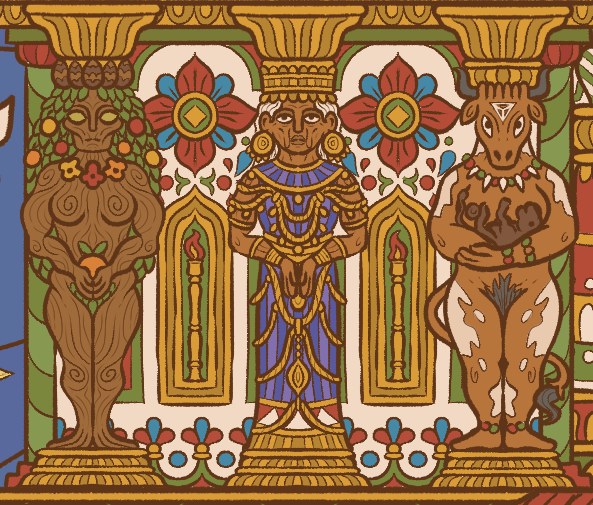
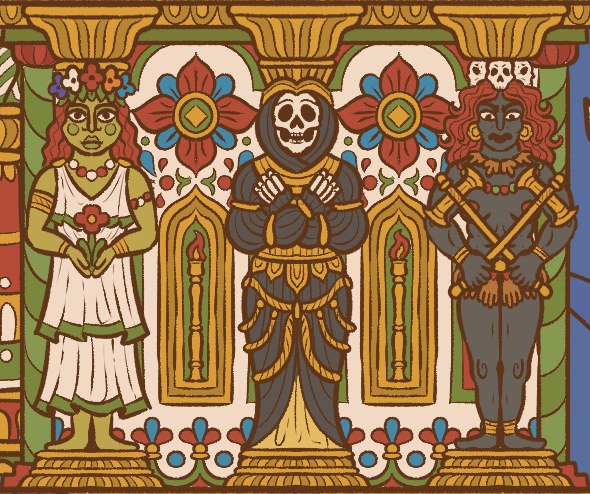
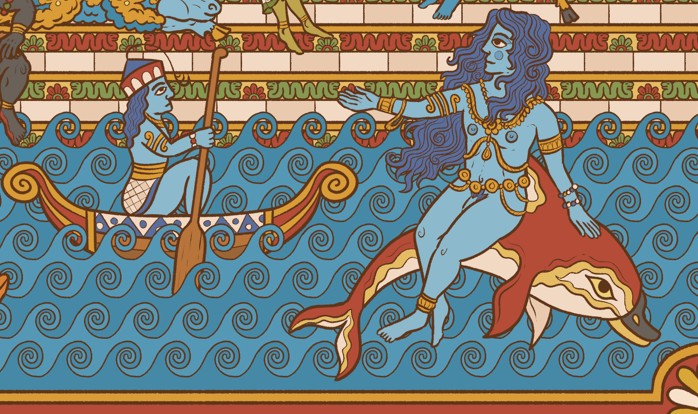

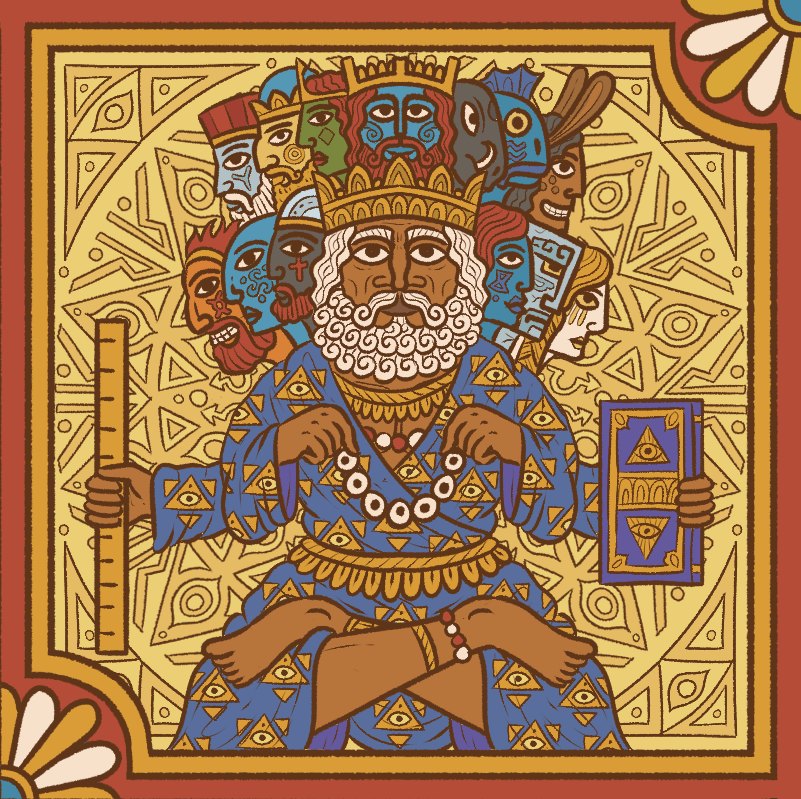
Click on the links to the Facebook sources after you have made your guesses about who and what is depicted to confirm or discuss your conclusions.
Converting Gamemasters to RuneQuest With the Starter Set
Guest entry by Jörg
On Facebook, Sven Lugar told about his seasonal gifting spree, targeting 14 GMs of other systems with a gift-wrapped Starter Set. Of that sample, 10 are willing to try it out, one still needs to get his players on board, and three haven’t reported back yet. And all of the non-GM friends who received one were wanting to try it out, too.
Kitbashing the Starter Set Pre-gens
Zagmuk posted pictures of their “kitbashed miniatures” on BRP Central, and they’re great! I only put four of them above, so follow the link for more character minis.
Elsewhere on Arachne Solara’s Web
Not everything is about Glorantha, although most things are! Here are loosely relevant things that we found on the interwebs.
Hidetaka Mizayaki’s Inspirations
ScreenRant has a story about EDGE Magazine’s interview with Hidetaka Mizayaki, creator of the Souls video game series (Dark Souls is the probably most famous of the lot) and the upcoming Elden Ring, among others. He cites RuneQuest as one of the inspirations for his next game, but don’t hold your breath for more information than that.
In the meantime, this is as good an opportunity as any to remind you that RuneQuest had a fairly complete product line in Japan in the 90s, although they had a completely wild array of custom artwork.
You can see more at this collector’s list, or on Runeblogger’s blog.
A Video on the Terramare Culture
Guest section by Jörg.
Dan Davis, the creator of these videos has published several novels set in Bronze Age Europe and provides some of his research in these quite accessible videos.
The Terramare culture offers a few visuals too good not to be robbed for Glorantha, like their stilt houses which could be used in regularly flooded terrain. Their position in the European trade network with the presence of standardized weights for both the Mycenaean and the Central European trade networks makes their role as a mediator between those environments quite plausible.
Thank you for reading
That’s it for this week! Please contact us with any feedback, question, or news item we’ve missed!




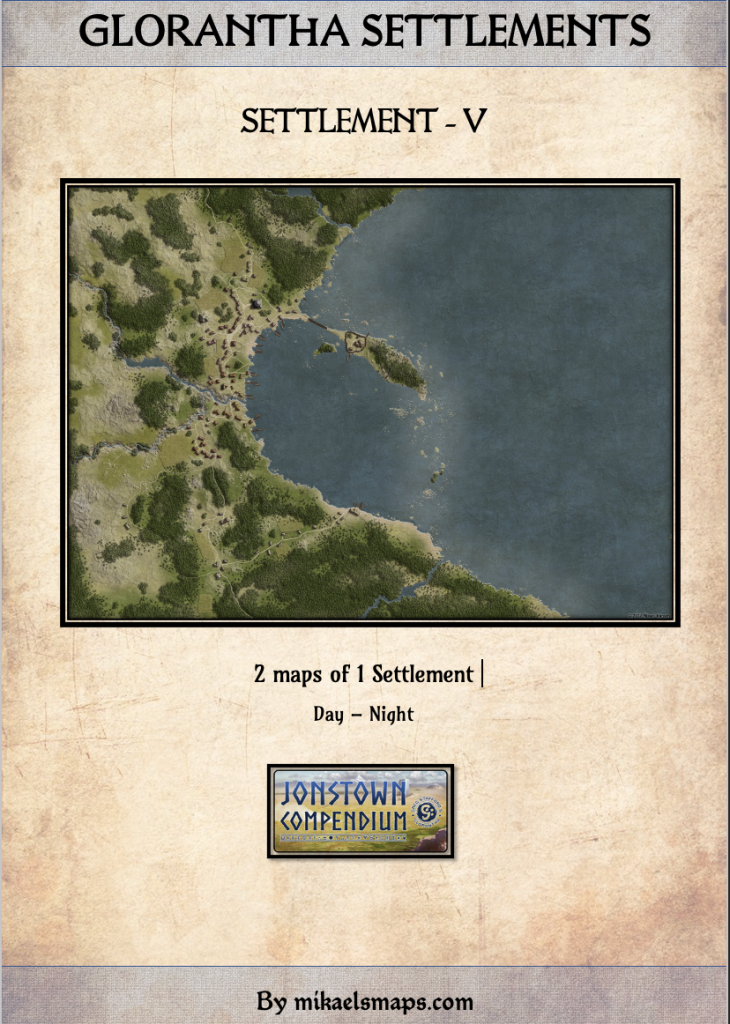
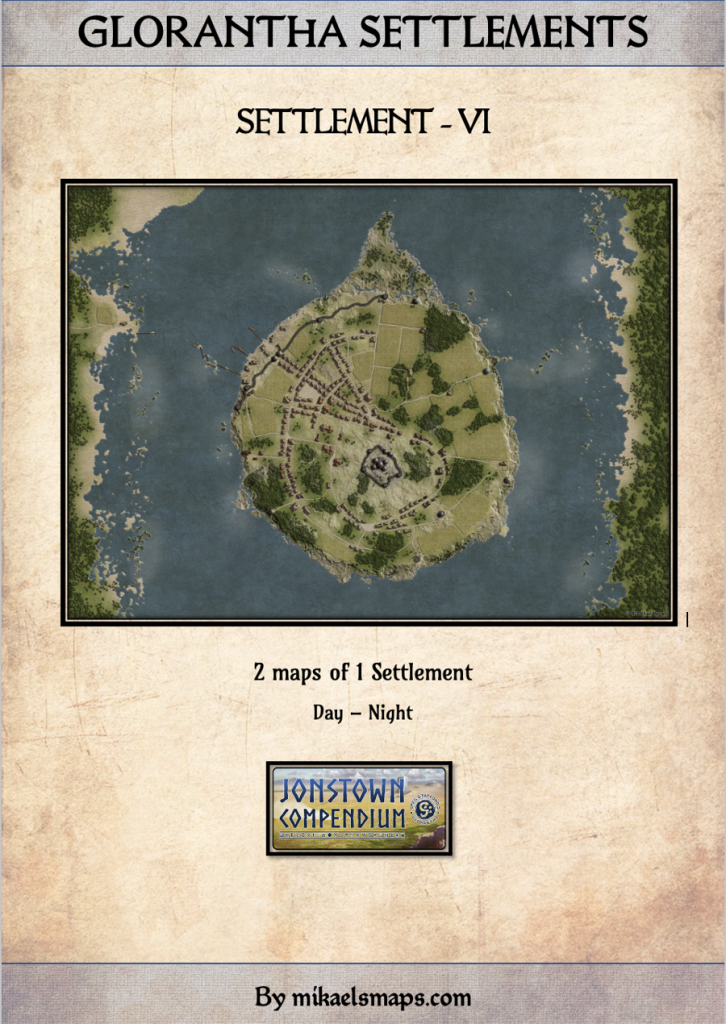


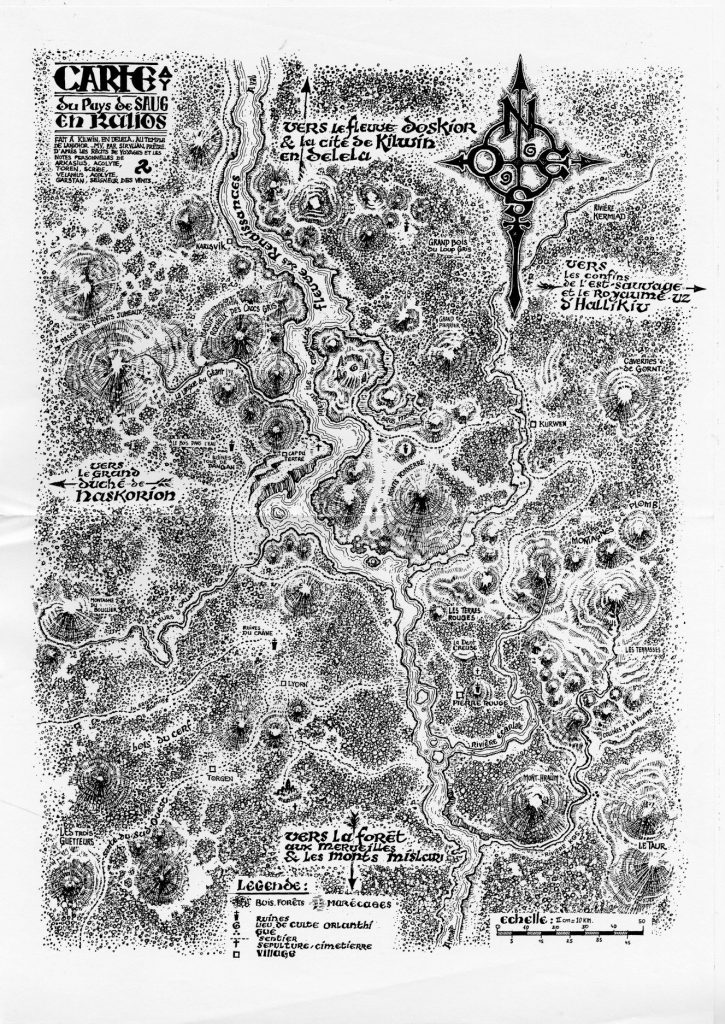

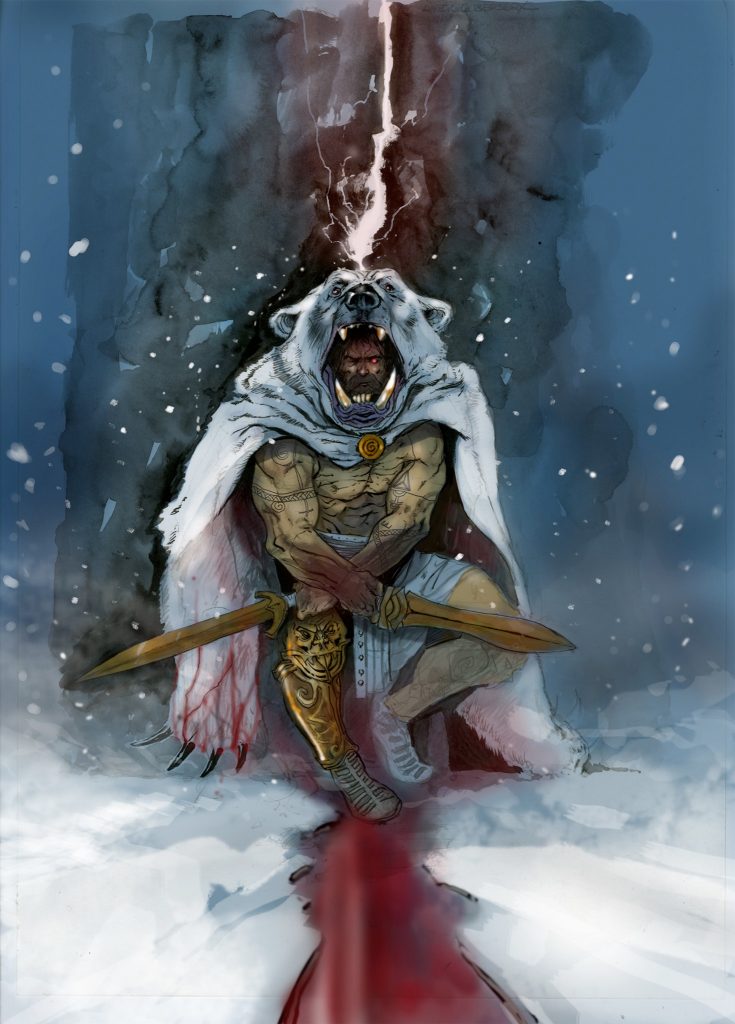
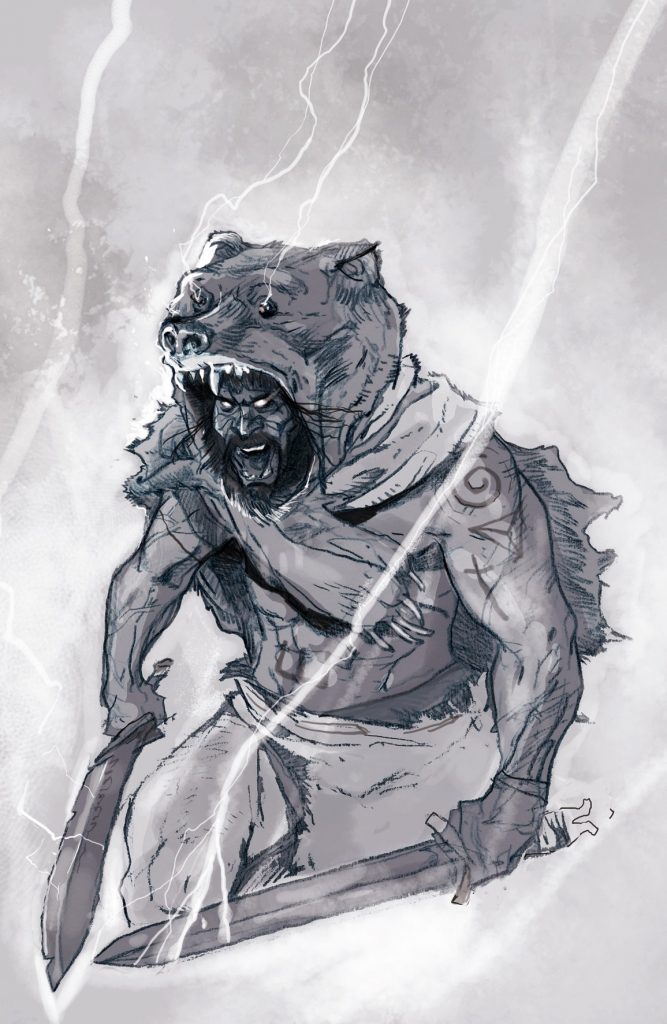
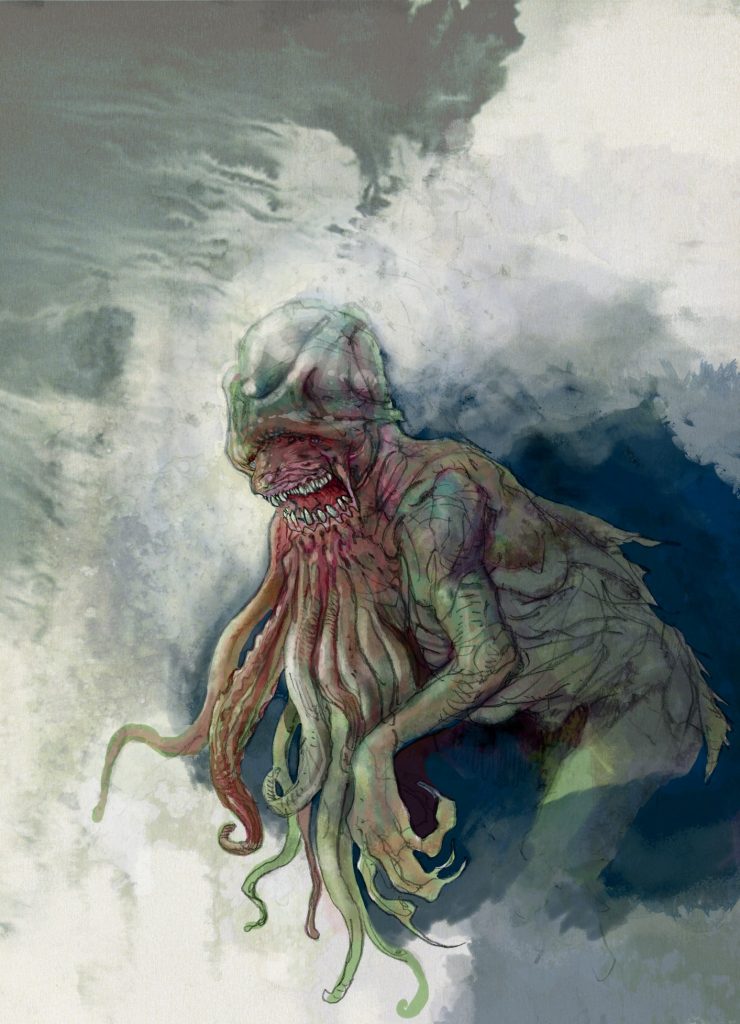
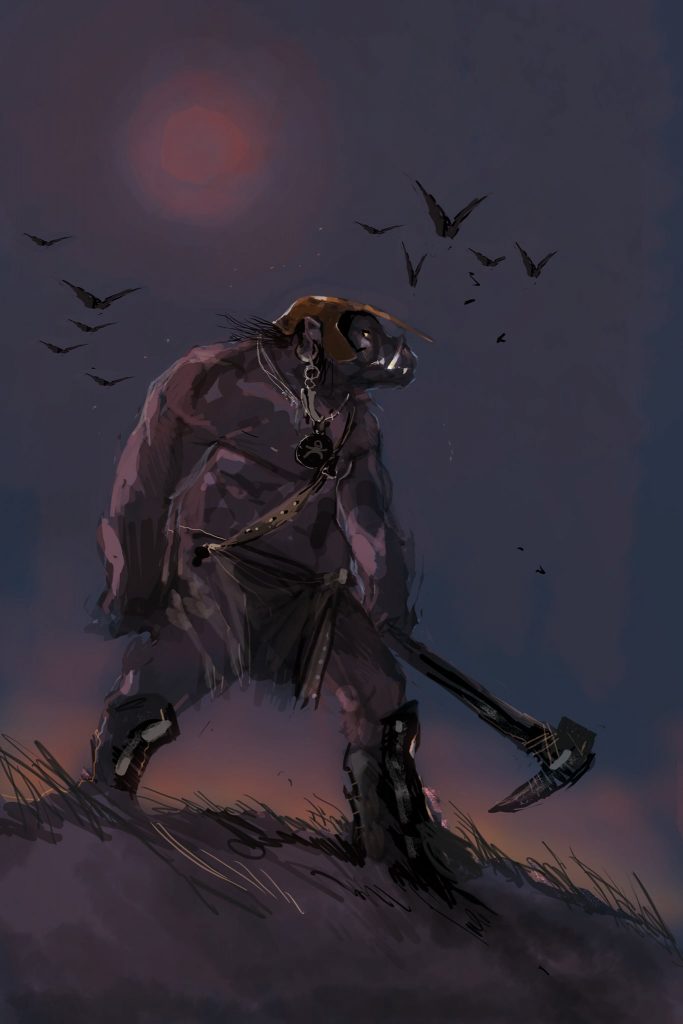


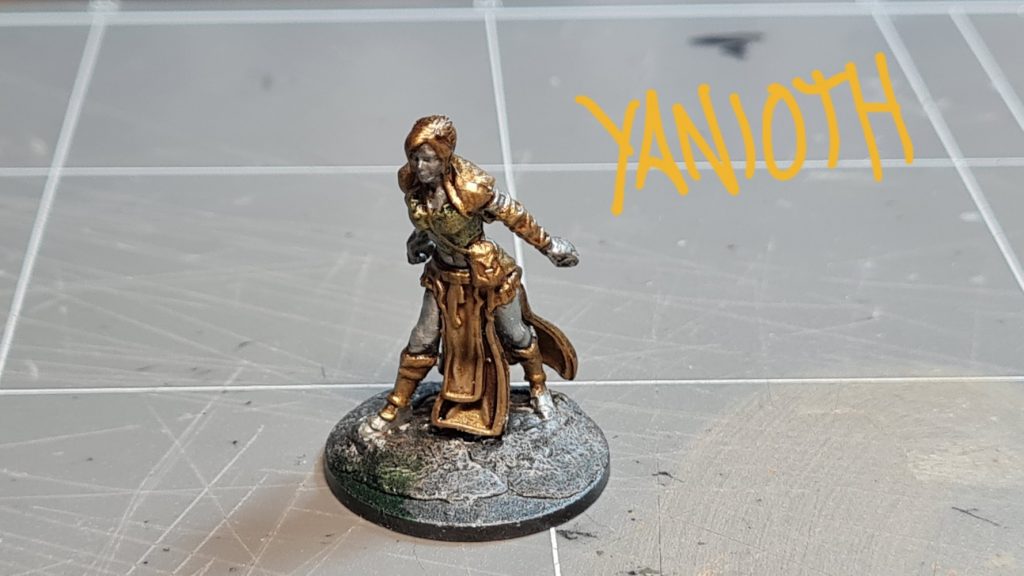
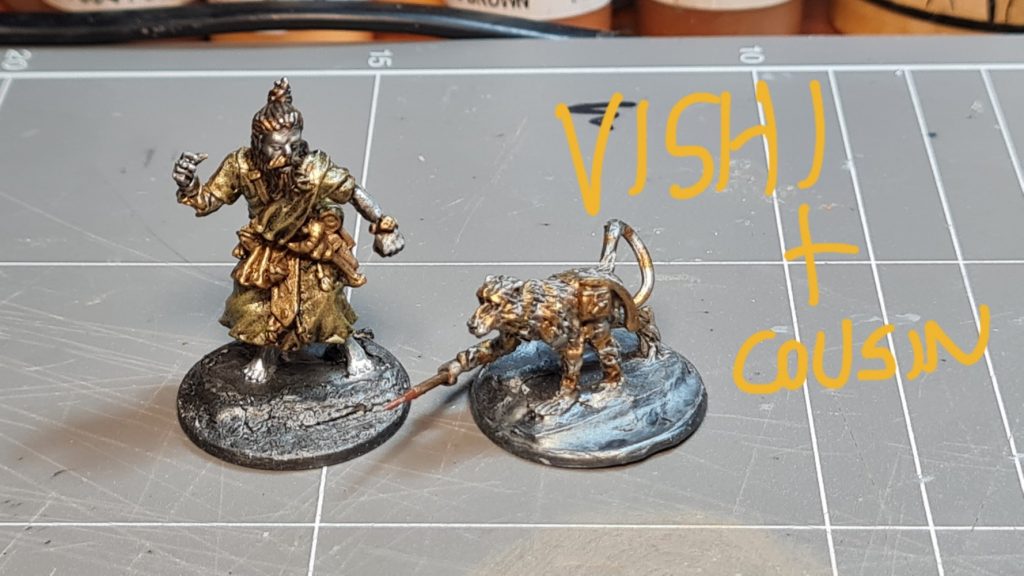
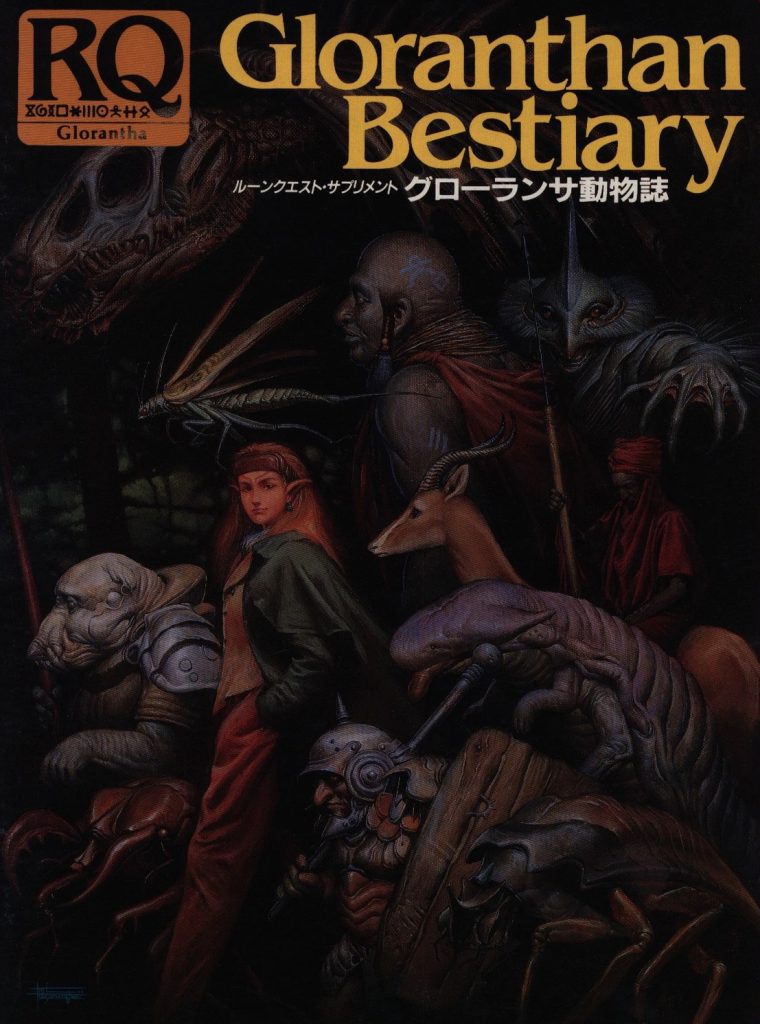
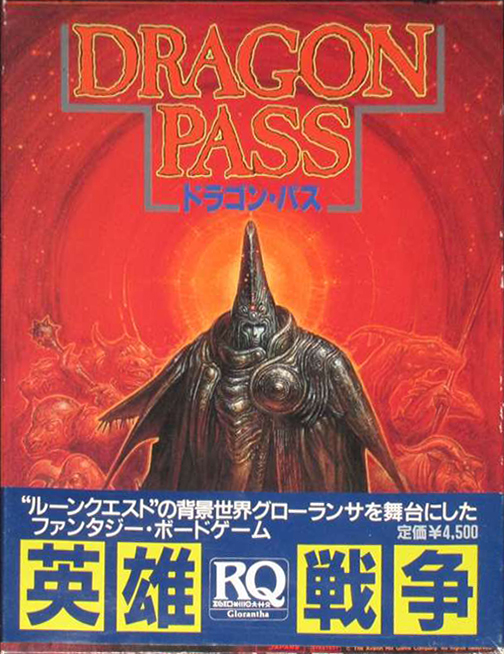
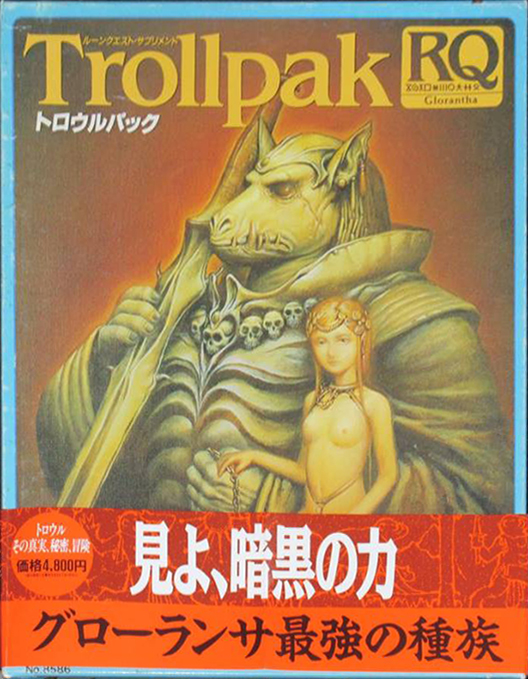
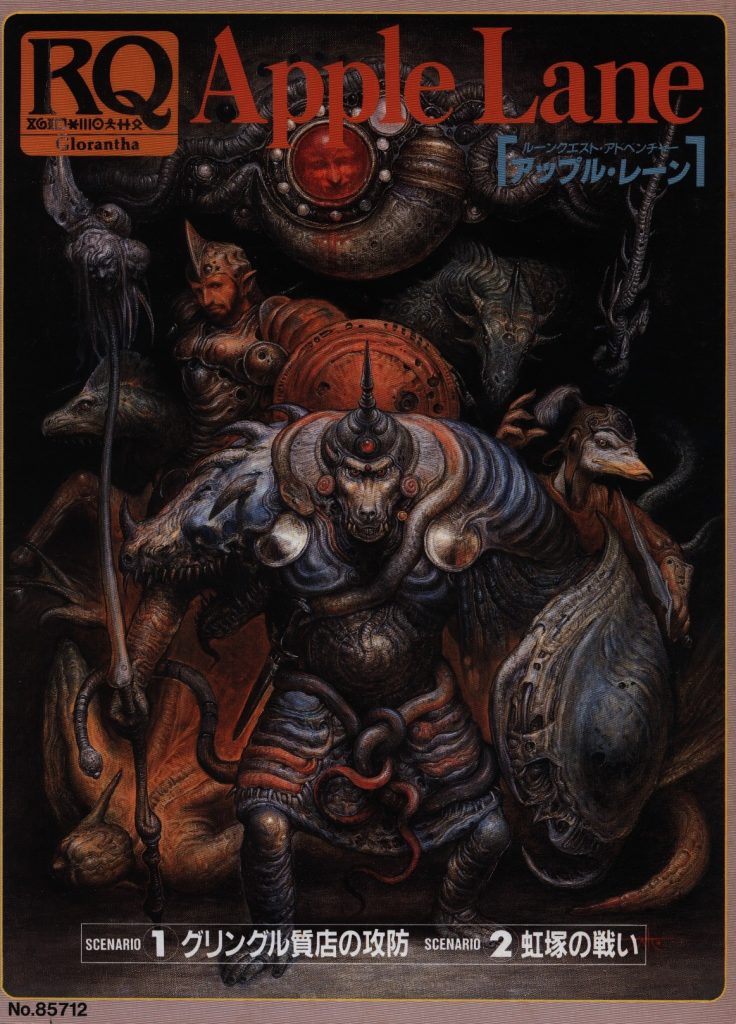
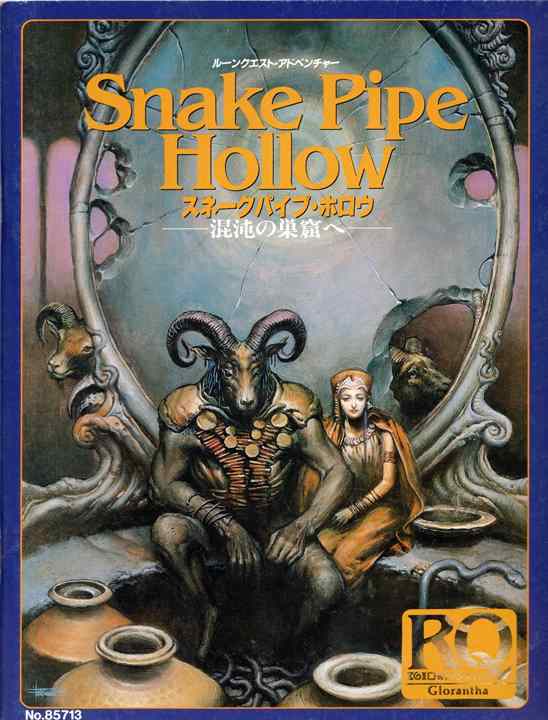
3 comments on “Journal of Runic Studies #30”